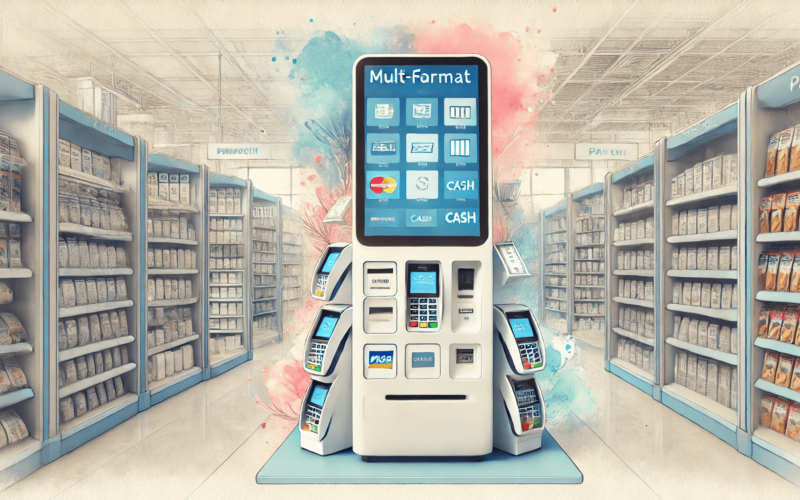The implementation of kiosks featuring multi-format payment systems has gained significant traction in both large and small retail stores. These self-service terminals enable customers to choose from a variety of payment options, such as credit cards, mobile wallets, and cash, providing an adaptable and user-friendly payment experience. However, this shift toward multifunctional kiosks brings its own set of challenges. While businesses are eager to embrace new technologies, many struggle with the integration of diverse payment systems. Additionally, incorporating cryptocurrency payments into kiosks has gained momentum, offering a promising solution to minimize transaction fees and enhance payment flexibility.
Retailers are increasingly attracted to multi-format kiosks because of their potential to improve customer satisfaction and streamline store operations. By offering a broad spectrum of payment methods, these kiosks aim to cater to the varied preferences of shoppers. Yet, if the integration of these systems is not carefully planned and executed, it may lead to technical glitches such as integration failures or payment processing issues. A deep understanding of kiosk functionality and payment system integration is essential for successful deployment and operation.
A key concern for businesses adopting multi-format kiosks is ensuring seamless integration with their existing infrastructure. Retailers must evaluate how the new technology will interact with their point-of-sale systems and backend networks. Another critical aspect is security, as the inclusion of multiple payment methods introduces new potential risks, including fraud.
Implementation of multi-format kiosks in stores
The integration of multi-format kiosks has proven to be an effective solution for many retail environments. These kiosks are designed to offer diverse payment methods such as credit cards, mobile wallets, and cash, creating a more flexible shopping experience for customers. However, the process of implementing this technology is not always straightforward, as it involves multiple steps to ensure everything works cohesively. One of the biggest challenges retailers face is the smooth integration of various payment systems into a single kiosk interface.
Retailers must first ensure that their payment systems are compatible with the kiosk software, which often involves upgrading or modifying existing POS systems. In some cases, these upgrades are necessary to accommodate the latest technology and security standards. While many kiosks are designed to be user-friendly, their integration with a store’s existing infrastructure can lead to delays and unexpected costs. Ensuring that payment systems are securely connected to the network and functioning correctly is a key concern for businesses transitioning to multi-format kiosks.
Another challenge retailers face when implementing these kiosks is dealing with customer resistance to new technology. Customers may be hesitant to use unfamiliar payment methods or may not trust the security of mobile wallets and card payments. As a result, businesses must focus on user education, providing clear instructions and ensuring that the kiosk interfaces are intuitive. Overcoming this resistance is critical to the successful adoption of kiosks, as it directly impacts the customer experience and overall satisfaction.
Challenges in adopting multi-format kiosks
The implementation of multi-format kiosks presents a variety of challenges that need careful consideration. Although they offer greater payment flexibility, integrating multiple payment systems into a single platform is complex. One of the most significant hurdles is ensuring the smooth functioning of all payment options, which requires ongoing updates to both hardware and software. Retailers must also manage technical support to troubleshoot issues that arise during the operation of these systems, making regular maintenance a key aspect of successful deployment.
In addition to technical complexities, businesses must also address customer-facing concerns. Many customers are still adjusting to the concept of self-service kiosks, and introducing multiple payment options can be overwhelming. Retailers must ensure that these kiosks are not only secure but also easy to use for customers of all ages and tech proficiency levels. Key considerations include ensuring that customers can quickly understand the interface and providing sufficient guidance on how to use the various payment methods available.
To navigate these challenges effectively, businesses need to focus on several key areas. They must invest in employee training to handle any technical issues that arise, as well as to guide customers in using the kiosks. Retailers should also prioritize selecting kiosks with robust security features to safeguard against fraud. To address customer concerns, a few best practices include:
- Clear instructions displayed on the kiosk screen
- Accessible customer service or support for troubleshooting
- Regular software updates to keep the kiosk secure and reliable
- User-friendly interfaces designed for all types of customers
By focusing on these areas, businesses can significantly improve the customer experience and increase the likelihood of successful kiosk adoption.
Selecting the ideal kiosk for your business
Choosing the appropriate kiosk for a business is a vital decision that directly impacts its efficiency and future success. Retailers must take into account several key factors, including store size, customer demographics, and the specific payment methods that will best serve their operational needs. The ideal kiosk should not only ensure smooth and efficient transactions but also complement the store’s broader goals, such as enhancing customer experience or boosting operational capacity. While some kiosks focus on simplicity, offering fundamental features, others come equipped with advanced capabilities, including multiple payment options and enhanced functionalities. As a result, businesses need to carefully assess their requirements to select the most suitable kiosk model.
The design and user experience of a kiosk are key factors in determining its effectiveness. A well-designed interface can significantly boost customer satisfaction and streamline the transaction process. Kiosks featuring intuitive touchscreens and clear, simple instructions are more likely to engage users, reducing both confusion and the chances of errors during transactions. On the other hand, a poorly designed interface can lead to user frustration, making it less likely that customers will opt to use the kiosk, ultimately slowing its adoption. For businesses, creating a user-friendly and accessible kiosk is essential in order to cater to a broad range of customers.
Finally, businesses should consider the long-term costs of kiosk implementation. While the initial investment in multi-format kiosks may seem high, the potential savings and increased revenue can outweigh the upfront expenses. Retailers must also factor in maintenance and service costs, as well as the need for future upgrades. When evaluating the total cost of ownership, it’s important to account for all factors, from installation to long-term upkeep, to make an informed decision.
Security and customer trust in payment systems
The introduction of multi-format kiosks in retail spaces brings forward significant challenges related to security and consumer trust. As more payment options become accessible, it is crucial for businesses to focus on protecting sensitive customer data. Kiosks handling transactions through credit cards, mobile wallets, or cash must comply with rigorous security protocols like encryption and tokenization to shield against fraud. Neglecting these essential security practices could lead to data breaches, severely harming the store’s reputation and undermining customer confidence.
Retailers must also ensure that their kiosks are regularly updated to keep pace with the latest security threats. Cybersecurity threats evolve constantly, and businesses need to be proactive in preventing potential breaches. This includes conducting regular system audits and installing the latest software patches to protect customer data. Without adequate security protocols, multi-format kiosks could expose both the business and its customers to unnecessary risks.
Alongside technical security, establishing customer confidence is crucial. A significant number of consumers remain hesitant to adopt new payment methods, especially mobile wallets and contactless cards, fearing potential security risks. Retailers can alleviate these worries by transparently highlighting the security protocols of their kiosks and reassuring customers about the protection of their transactions. In the end, a blend of solid security practices and customer education will build trust and promote wider acceptance of multi-format kiosks.
Questions and answers
Implementing multi-format kiosks presents challenges such as ensuring smooth integration with existing systems, managing customer resistance to new technology, and maintaining security.
Businesses can improve customer trust by ensuring strong security measures, providing clear instructions on kiosk usage, and regularly updating software to prevent security breaches.
Multi-format kiosks help streamline store operations by reducing the need for cashier staff, lowering the potential for human error, and improving overall transaction efficiency.

